60 years
Eichmann trial:
That little red dot

“I couldn’t see my wife any more, she was swallowed up in the crowd. I couldn’t see my son any more either, he was swallowed up in the crowd, but my little daughter […] had a red coat, and that little red dot getting smaller and smaller, this is how my family disappeared from my life.”
Speaking on May 25, 1961, this is how Martin Földi described the moment in April 1944 when he lost his family forever. He was one of 110 witnesses who testified against Nazi criminal Adolf Eichmann in the so-called Eichmann trial.
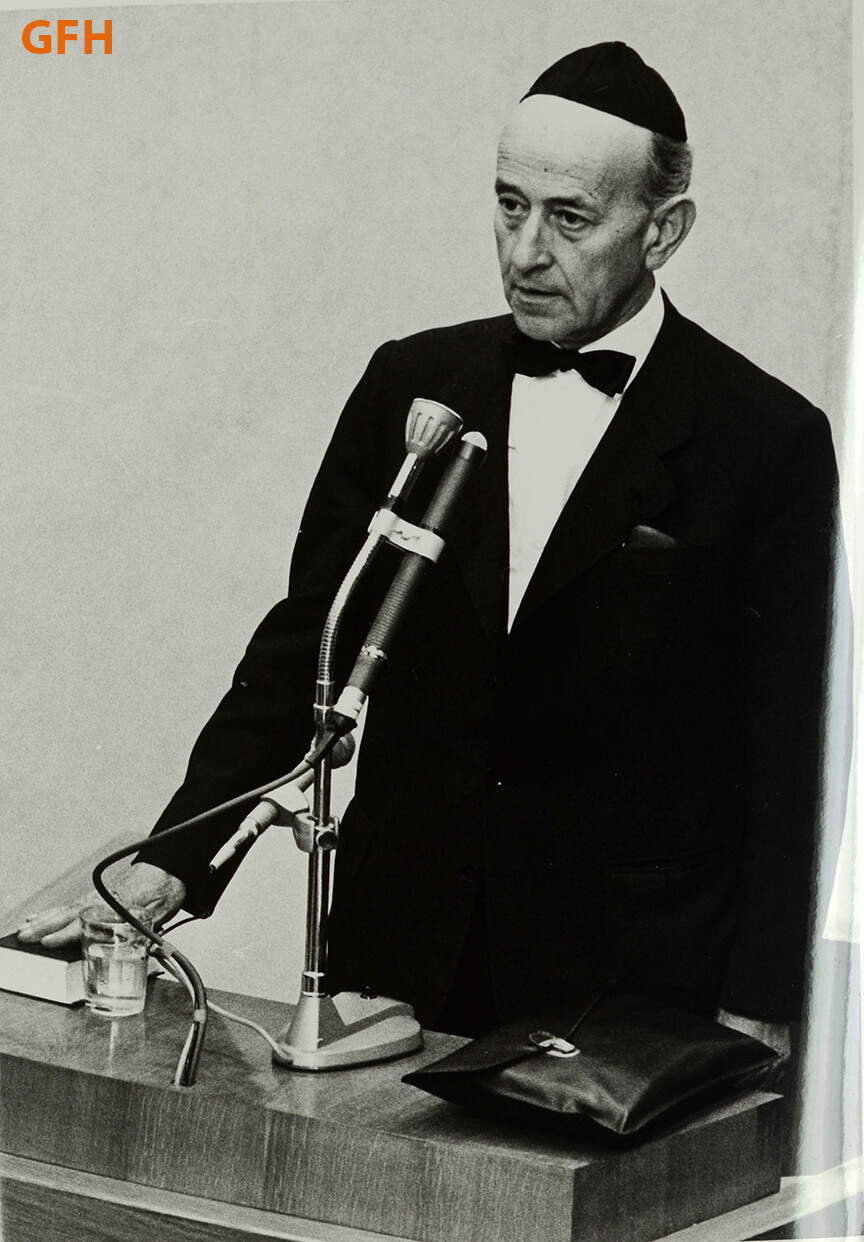
Dr. Martin Földi during his testimony. Courtesy: The Ghetto Fighters’ House Museum, Israel/ The Photo Archive
Földi’s testimony describes a key moment in the trial – in the eyes of Deputy Prosecutor Gabriel Bach. “My daughter Orli was exactly two and a half years old, and I had bought her a red coat two weeks before. When the witness said that, and I heard it for the first time, about this little red dot, I suddenly couldn’t utter a sound.”
Sixty years on, Gabriel Bach still remembers that moment clearly. Now 94 years old, whenever he talks about the “trial of his life” in interviews, he tells the story of the girl with the red coat, which made a lasting impression him. Bach now lives in Jerusalem. He was 11 years old when he and his family managed to flee Germany for the Netherlands shortly before the November pogroms in 1938. They survived World War II in Palestine. Unlike the Bachs, the Földi family did not manage to escape from the Nazis.
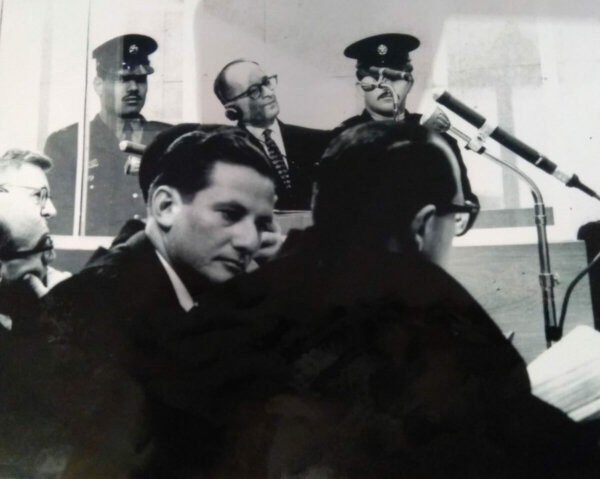
Gabriel Bach during the trial in the forefront, Adolf Eichmann between two police officers in the back. Copyright: United States Holocaust Memorial Museum, courtesy of Eli M. Rosenbaum
“At that moment, I couldn’t lie.”
Martin Földi was a lawyer, and he lived with his wife Erzsebet and their children Anna and Gyorgy in Kaschau, Hungary (now Košice in present-day Slovakia) until the Nazis deported them on April 21, 1944. When they arrived in Auschwitz, the Földis were immediately selected and separated. Erzsebet and seven-year-old Anna were herded together with the group of women and children, Martin and 12-year-old Gyorgy were sent to the other group.
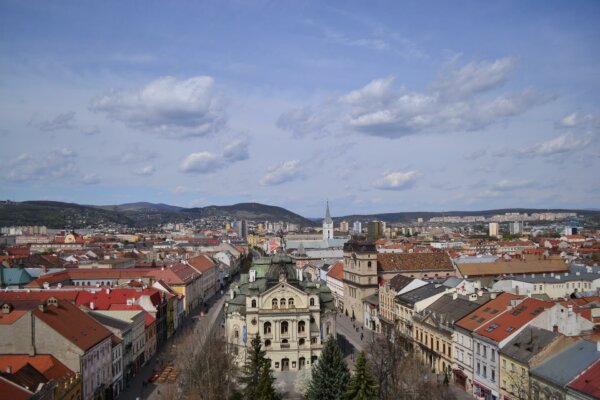
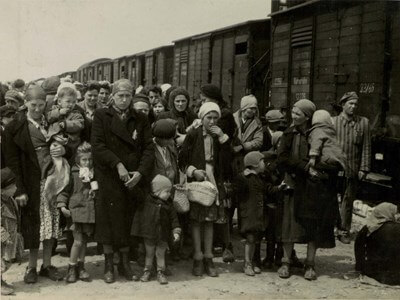
“Then they told us: Men to the right together with boys over the age of four, and women and the children to the left. And we saw that the women were already going, and we were still standing. Until they almost disappeared. I was standing with a son of mine who was only twelve years old.”
Note: We suspect that there is a translation error in the recording of Martin Földi’s testimony. Instead of: “Then they told us: Men to the right together with boys over the age of four, and women and the children to the left.” it should be: “Then they told us: Men to the right together with boys over the age of fourteen, and women and the children to the left.”
Shortly afterwards, father and son were also torn apart. In Auschwitz, the German occupying forces selected people they deemed able to work and separated them from those they deemed unable to work. Women with young children and the elderly were considered unable to work and were murdered directly in the gas chambers.
“Later on when we moved I saw a man who was wearing a German army uniform. […] Then he asked: How old is your son? At that moment, I couldn’t lie, and I told him my boy is twelve. And then he asked: Where is Mummy? And I said: She went to the left. Then he said to my boy: Alright, run, join your .”
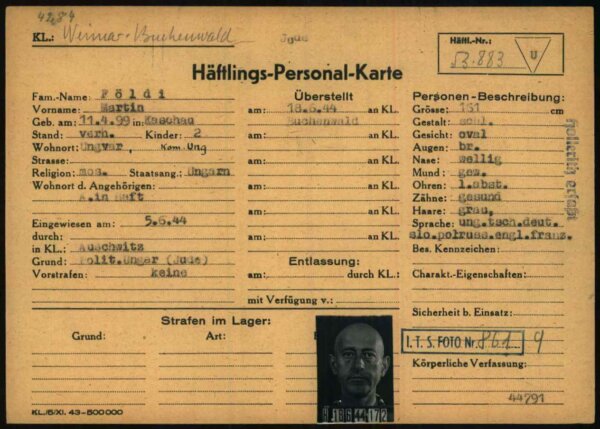
Martin Földi´s Prisoner Registration Card
The video recording of Martin Földi giving evidence at the Eichmann trial is a moving testimony of the Holocaust. Research in our archives and in Yad Vashem documents the fate of the family. Three photos of Erzsebet and the children, which Martin Földi made available to the Yad Vashem archive, have been preserved to this day and still give us an impression of who the people behind this tragic story were.
The Holocaust in the public eye
The trial aroused a great deal of media interest, and the testimony of hundreds of witnesses brought the Holocaust into public consciousness. The court found Adolf Eichmann guilty on December 15, 1961. The “organizer of the Holocaust” was hanged in Israel on the night of May 31–June 1, 1962.
Prosecutor Gabriel Bach suspects that the emotional testimony given by Martin Földi and the part where he speaks about his daughter as a little red dot inspired the makers of the film “Schindler’s List” to show a little girl with a red coat in the Warsaw ghetto.

